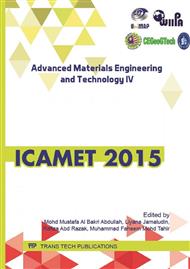[1]
H. J. Lee, T. T. Goodrich, and R. M. Corn, SPR imaging measurement of 1-D and 2d-DNA microarrays created from microfluidic channels on gold thin film, Anal. Chem. 73 (2001) 5525-5531.
DOI: 10.1021/ac010762s
Google Scholar
[2]
D. Kamarun, N.H.K.A. Azem. S. H. Sarijo. M. Abdullah and A. F. Mohd, Nanopolyaniline for immobilization of biomolecules: premilinary study, Mater. Resea. Innov. 15 (2011), 193-197.
DOI: 10.1179/143307511x13031890749055
Google Scholar
[3]
J. Homola, M. Piliarik and L. Párová, High-throughput SPR sensor for food safety, Biosens. Bioelectron, 24 (2009), 1399-1404.
DOI: 10.1016/j.bios.2008.08.012
Google Scholar
[4]
E. Kretschmann and H. Raether, Radiative decay of non-radiative surface plasmon excited by ligh, Z. Naturforsch, A 23 (1968), 2135-2136.
DOI: 10.1515/zna-1968-1247
Google Scholar
[5]
S. Scrarano, M. Mascini, A. Turner and M. Minunni, Surface plasmon resonance imaging for affinity-based biosensor", Biosens. Bioelectron, 25 (2010), 957-966.
DOI: 10.1016/j.bios.2009.08.039
Google Scholar
[6]
Y. Shin, H. Kim, Y. Jung and B. Chung, a new plam-sized surface plasmon resonance (spr) biosensor based on modulation of a light source by a rotating mirror, Sens. Actuators B 150 (2010), 1-6.
DOI: 10.1016/j.snb.2010.08.006
Google Scholar
[7]
P. Novo, V. Chu, and J. Conde, Integrated optical detection of autonomous capillary microfluidic immunoassays: a hand held point of care prototype, Biosens. Biolectron, 57 (2014), 284-291.
DOI: 10.1016/j.bios.2014.02.009
Google Scholar
[8]
K. Retra, H. Irth, and J. E. van Muiklwijk-Koezen, surface plasmon resonance biosensor analysis as a useful tool in FBDD, Drug Discovery Today: Technologies, 3 (2010) 181-187.
DOI: 10.1016/j.ddtec.2010.11.012
Google Scholar
[9]
Information on http: /www. ibis-spr. n1/p.1. php.
Google Scholar
[10]
T. M. Chinowsky, J. G. Quinn, D. U, Bartholomew, R. Kaiser and J. L. Elkind, Perfomance of the spreeta 2000 integrated surface plasmon resonance affinity sensor, Sensors and actua B 91 (2003) 699-705.
DOI: 10.1016/s0925-4005(03)00113-8
Google Scholar
[11]
W. M. A. W. Ahamad, D. Kamarun, M. K. A. Rahman and M. S. Kamarudin, Modular surface plasmon resonance (spr) biosensor based on wavelength modulation, Adv. Mater. Reseacrh, 1107 (2015) 699-705.
DOI: 10.4028/www.scientific.net/amr.1107.699
Google Scholar
[12]
K, Wang and X. Zhang, Double-incident angle technique for surface plasmon resonance measurements, Optics. Commun, 351 (2015) 140-143.
DOI: 10.1016/j.optcom.2015.04.054
Google Scholar
[13]
J. Li, R. Cheng, M. Wang, S. Wang, H. Liang, X. Hu, X. Sun, J. Zhu, L. Ma, M. Jiang and J. Hu, A low cost of surface plasmon resonance biosensor using a laser liner generator, Optic. Communi, 349 (20015) 82-88.
DOI: 10.1016/j.optcom.2015.03.035
Google Scholar
[14]
J. Dostálek and J. Homola, Surface plasmon resonance sensor based on array of diffraction gratings for highly parallelized observation of bio-molecular interactions, Sens. Actuators B Chem, 129 (2008) 303-310.
DOI: 10.1016/j.snb.2007.08.012
Google Scholar
[15]
R. Karlsson, and A. Fält, Experimental design for kinetic analysis of protein-protein interactions with surface plasmon resonance biosensors, J. Immunol. Methods, 200 (1997) 1-2.
DOI: 10.1016/s0022-1759(96)00195-0
Google Scholar
[16]
G. G. Nenninger, M. Piliarik, and J. Homola, Data analysis for optical sensors based on spectroscopy of surface plasmon, Meas. Sci. Technol, 13(12) (2002), 2038-(2046).
DOI: 10.1088/0957-0233/13/12/332
Google Scholar
[17]
J. T. Hastings. J. Guo, P. D. Keathley, P. B. Kumaresh, Y. Wei, S. Law, and L. G. Bachas, Optimal-sensing referenced sensing using long- and short- range surface plasmon, Opt. Express, 15(26) (2007), 17661-17672.
DOI: 10.1364/oe.15.017661
Google Scholar
[18]
M. Packirisamy, H. SadAbadi, S. Badilescu and R. Wüthrich, Integration of gold nanoparticles in PDMS microfluidic for lab-on-chip plasmonic biosensing of growth hormones", Biosens. Bioelectron, 44 (2013) 77-84.
DOI: 10.1016/j.bios.2013.01.016
Google Scholar


